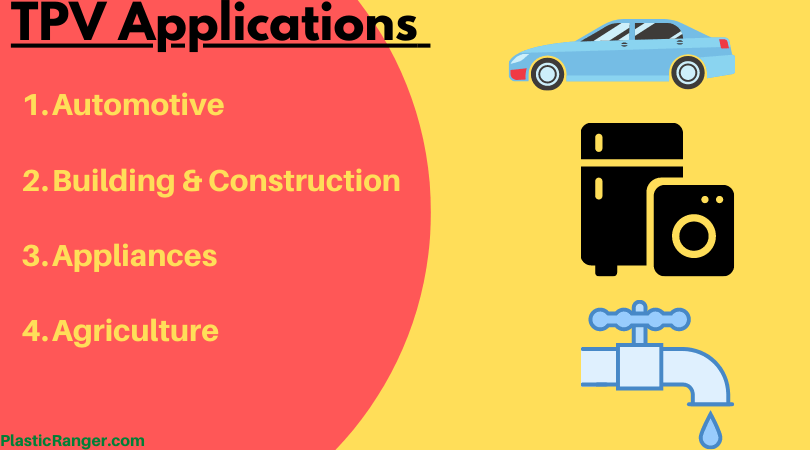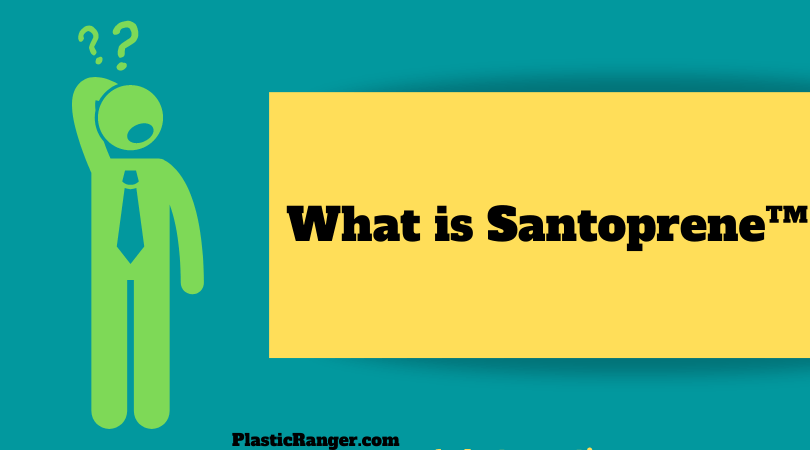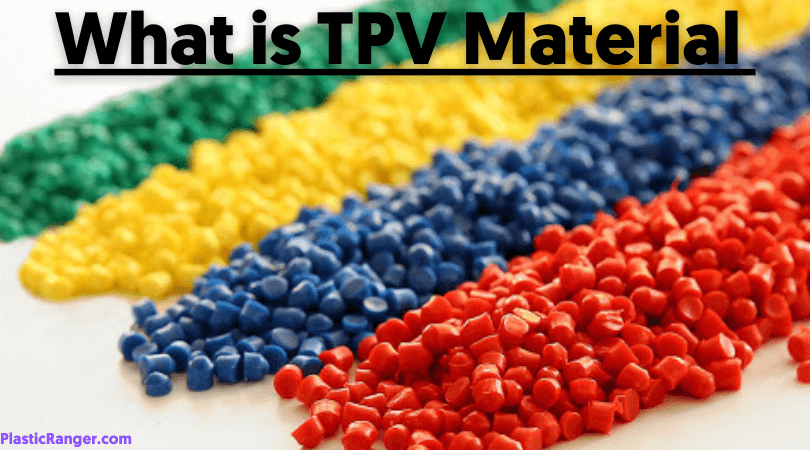Hello everybody, today I will share a phenomenal guide on thermoplastic vulcanisate. A hybrid between plastic and rubber was invented to create revolutionary products.
What is TPV Material?
TPV stands for Thermoplastic Vulcanizates, primarily comprised of polypropylene and EPDM, making them both elastic and capable of thermoplastic processing. As a subclass, they fit into the broader category of Thermoplastic Elastomers (TPE).
Like TPR and TPU, It is an invention that has helped bridge the gap between plastic and rubber.
Thermoplastic vulcanisate is a form of rubber that has been vulcanized utilizing the compounding process.
That means polymers are transformed into more durable materials through the participation of crosslinks.
The compounding process makes the TPV rubber extraordinarily flexible and customizable, thus increasing its potential applications significantly.
It is called by many experts, which blurs the line between plastics and rubber.
TPV is an alloy comprised mostly of fully cured EPDM Rubber(Synthetic rubber) compressed in a matrix similar to polypropylene (PP).
TPVs majorly include acrylate rubber TPV (ACM), silicone rubber TPV (TPSiV), TPV based on NR or ENR, and polyolefin elastomer (EOC) / PP TPV).
Thanks to its easy customization properties, it steadily replaces traditional thermosetting vulcanized rubber in many industries like automobile, electronics, construction, and agriculture.
The material is available in three physical forms – pallets, solids, and granules.
TPV Material: Key Properties
| Property | Temperature | Value |
| Mechanical | ||
| Tensile Strength | at 200-750% strain | – |
| Elongation | 23.0 °C | 200 – 750 % |
| Thermal | ||
| Melting Point | – | 220 °C |
| Flammability | UL 94 HB | – |
| Coefficient of thermal expansion | 23.0 °C | 5E-5 – 8E-5 1/K |
| Max service temperature, long | – | 130 – 135 °C |
| Max service temperature, short | – | 130 – 135 °C |
| Electrical | ||
| Dielectric constant | 23.0 °C | 3.5 – 4 [-] |
| Electrical resistivity | 23.0 °C |
5.00E+13 – 5.00E+15 Ω·m
|
- High resistance to a wide range of solvents, fats, and oils.
- 100% recyclable
- Excellent thermal resistance
- High durability makes the material withstand any significant deformation.
- Meager impact by aggressive outdoor exposures.
- Great barrier properties.
- Good processability
- Easy adhesion PE and PP for multiple-part applications
- Brands and Suppliers
Below is the list of top suppliers and brands of TPV material:
| Supplier | Brand |
Origin Country
|
| ExxonMobil Chemical | SANTOPRENE™ | United States |
| Teknor Apex | Sarlink® | United States |
| Elastron | Elastron® | Turkey |
| MOCOM Compounds | ALFATER XL® | Germany |
| Celanese | FORPRENE ® | Italy |
Interesting Read – What is ABS Plastic | The Definitve Guide
TPV Materials Applications

- Automotive
- Building & Construction
- Appliances
- Agriculture
Automotive
The automotive industry is moving towards making less pollution-emitting and lightweight vehicles to reduce carbon emissions by sector.
TPV comes to the rescue with its excellent thermal resistance and barrier properties, which makes it ideal for such applications
TPV rubber is essential in car and truck interior parts, tires, under-the-hood applications, exterior, and chassis.
Building & Construction
The thermoplastic vulcanisate compound has excellent weathering properties and durability.
It is perfect for building and construction applications like pipes & fittings, glazing seals, waterproofing membranes, decorative and fabric coatings, and wall coverings.
Appliances
The lightweight capabilities of thermoplastic vulcanisate can reduce manufacturing and labor costs for manufacturers.
TPV plastic is often used to make interior and exterior parts for appliances like washing machines, dishwashers, ovens, microwaves, hair dryers, and shavers.
Agriculture
Resistance to aggressive fluid and a good compression set make TPV plastic ideal for manufacturing pipe seals and other fluid-contact products.
Santoprene™

Santoprene™ is a high-performance TPV brand owned, produced, and supplied by ExxonMobil Chemical Company, based in the United States.
The word “Santoprene” was trademarked in the year 1977. It is the most popular and widely known TPV brand in North America.
Its high-performance nature makes it compatible or applications in automotive, industrial goods, and consumer products.
Key Benefits
- Fabulous aesthetics with strength and flexibility
- Sustainable benefits like weight reduction sustained manufacturing and recycling compared to thermoset rubber (TSR) or ethylene propylene diene polymethylene backbone (EPDM) rubber.
Processing
TPV can be handled using standard thermoplastic methods such as injection molding, blow molding, and extrusion, making manufacturing less complicated than rubber.
TPV comes ready for use, eliminating the need to mix it with components like reinforcing fillers (carbon black, mineral fillers), stabilizers, plasticizing oils, and curing systems.
Compared to rubber processing, TPV thermoplastic processing offers several advantages, such as quicker cycle times, higher output rates per hour, and the ability to repurpose processing scrap.
These factors contribute to cost savings, reduced need for tooling/machinery, lower scrap expenses, and improved efficiency in material logistics.
After a brief drying period, TPV pellets are automatically moved to the molding machine or extrusion line.
The production cycle can be considerably shorter because the parts don’t need to cure in the mold as with rubber, which typically takes two to three minutes.
For TPV parts, only a cooling period is required, usually around 30 seconds, after which they can be removed from the mold or further cooled in water.
Processing Options
Injection molding: You can use simple plastic machines to shape Santoprene TPV. It’s faster than using a type of rubber called a thermoset.
Plus, TPV is flexible so that you can make more complex shapes.
Insert molding: This is when you put a shaped piece of something into the mold and then fill the mold with TPV.
If the two materials get along, they’ll melt together where they touch. How strong this melted spot is depends on how hot it gets, how clean the shaped piece is, and how hot the TPV gets.
Extrusion: It’s easy to squeeze Santoprene TPV into all sorts of shapes, from simple to complex.
You can even co-extrude it, meaning you squeeze it out with other stuff to make a part that’s both hard and soft.
Two-shot injection molding: TPV can be mixed with other plastics by making two things simultaneously.
This lets you create a wide range of stuff, like hard and soft items. This is better than insert molding because you don’t need to mess with the shaped piece first.
Blow molding: Santoprene TPV can be blow molded, like blowing a bubble with different layers. It’s a versatile material used in many blow molding techniques.
Thermoforming: When you heat Santoprene TPV, it behaves like an ABS plastic. It holds its shape well and doesn’t sag or droop unpredictably.
If you use it to make a sheet for thermoformed parts, it keeps all its good qualities, like being able to be colored, resisting damage, standing up to weather and chemicals, not slipping, and having a nice matte surface that feels good to touch.
Differences Between TPV and TPE
| TPV | TPE |
| TPV is a stable elastomer made by mixing EPDM + dynamically vulcanized PP. |
A material made by blending thermoplastic rubber and other auxiliary materials
|
| Non-toxic, environmentally friendly, doesn’t contain nitrite and heavy metals, and can be recycled to achieve sanitation standards for coping with SGS certification and EU ROHS norms. |
Non-toxic, environmentally friendly, doesn’t contain carcinogenic substances, and can be recycled to achieve food sanitation standards.
|
| Slight changes in hardness can be seen in varied temperatures, ideal temperature range of – -30 ºC ~ 120ºC |
Slight changes in hardness can be seen in varied temperatures, ideal temperature range of – -30 ºC ~ 80ºC.
|
| The Shore hardness is 5A in the temperature range of -20 ºC ~ 40ºC, which is much better than PVC and EPDM materials. |
The Shore hardness is 4A in the same temperature range.
|
| Good aging resistance |
Good aging resistance
|
| Good weathering resistance |
High Tearing strength
|
Fascinating Read – What is LDPE Material? | The Complete Guide
FAQs
What is the difference between EPDM and TPV?
But TPV and EPDM have their pros and cons, EPDM rubber has limited colour options but provides better abrasion resistance.
It also boasts a higher heat resistance TPV (160°C vs. 100°C). On the other hand, TPV offers greater design flexibility and lower fabrication costs for intricate shapes and designs.
What is the difference between TPV and PETG?
If we compare both of them side by side, PETG is more flexible and durable. On the other hand, TPV is not as dense as PETG.
In terms of chemical resistance, TPV is a good choice, and PETG is an excellent choice.
What is the difference between TPV and PLA?
TPV and PLA have some subtle differences. PLA is more environmentally friendly and compostable. It is easier to print and can prove to be an ideal material for beginners. TPV is good for molding flexible parts that need to be able to return to their originals State.
What is the difference between TPV and TPO?
TPO is an abbreviation for thermoplastic polyolefin, which means thermoplastic elastomer material with polyolefin added.
On the other hand, TPV is short for thermoplastic vulcanisate.
TPV has a better heat resistance and tensile strength elastomeric physical properties and TPO is known for its robust chemical and impact resistance.
What is the difference between TPE vs TPV?
TPE, or Thermoplastic Elastomers, and TPV, or Thermoplastic Vulcanizates, are parts of the thermoplastic family but have different chemical properties.
TPV rubber can be considered a variant of rubber similar to EPDM in terms of performance and responsiveness.
Moreover, TPE is known on its excellent processability and robust chemical resistance. On the other hand, TPV is known for its durability and thermal resistance.
Suggested Read
- What is PETG Material? | The Definitive Guide
- What is PET Plastic | PET Characteristics | PET Copolymers | How is PET Made | Advantages & Disadvantages
- 7 Types of Plastics | An Helpful Illustrated Guide
- How is Plastic made? A Simple and Detailed Explanation.
- When Was Plastic Invented? | The History of Plastics
- What is UHMW Plastic Material? | The Definitive Guide
- What is Polystyrene? | The Definitive Guide
The Takeaway
Thermoplastic Vulcanizates (TPV) are versatile materials combining rubber’s elasticity and plastics’ processability. These properties make TPV suitable for a broad range of applications.
They offer cost efficiency and design flexibility in manufacturing processes like injection molding, insert molding, and extrusion.
Furthermore, TPV’s ability to bond with other materials and its impressive resilience against weather and chemicals make it a valuable alternative to traditional rubber, contributing to its rising popularity in various industries.
Thanks for reading. Kindly post your reviews and thoughts in the comment box.
Quick Navigation


can u add others brands from china?
Great post! I’m really interested in learning more about TPV materials and their applications. As someone who works in the manufacturing industry, it’s important for me to stay up-to-date on the latest materials and technologies. Your guide was informative and well-written, and I appreciate the detailed explanations and examples. Keep up the good work!